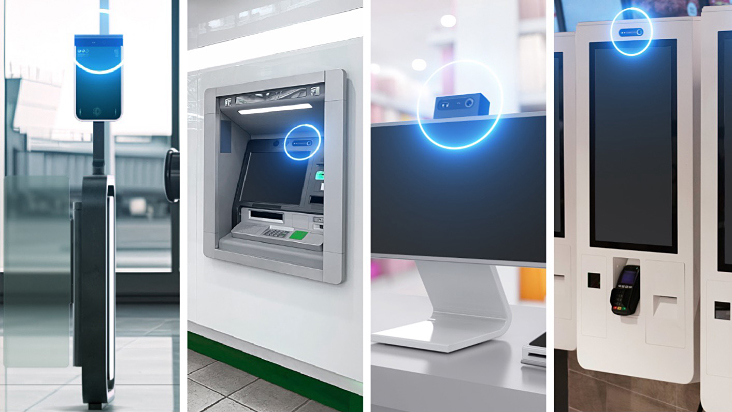What’s on the Horizon: 10 Biometric Trends for 2025
People expect a certain level of convenience when it comes to digital encounters. Due to their many benefits, biometric technologies are meeting — and exceeding — that expectation. As businesses and consumers continue to recognize the value and embrace the expediency offered by biometric technologies, adoption will continue to soar across sectors in 2025.
This surge in adoption, however, also necessitates important discussions about the ethical implications, privacy concerns, and responsible development of these powerful solutions to ensure a future where biometrics serve humanity ethically and equitably.
Below are the key biometric trends we anticipate will shape the identity authentication and verification landscape throughout 2025.
1. Contactless Biometrics
The push for hygiene-friendly, non-invasive security solutions will continue to drive the development and deployment of contactless biometric systems. Facial recognition and palm/fingerprint technologies often require no physical interaction — that is, no human intervention such as a cashier or attendant and no need to physically touch a device with hand "hover" and facial scans.
2. Multi-Modal Biometrics
The integration of multiple biometric modalities (such as facial recognition, fingerprint scanning and voice recognition) into single authentication systems will become more common. This helps improve security and user experience by providing multiple layers of fast, frictionless authentication.
3. Image Quality Assessment
High-quality image capture is the first critical step to achieving accurate biometric results. To maintain flawless performance in demanding environments like air travel, banking and border control, biometric scanners — such as facial recognition cameras and fingerprint readers — must incorporate sophisticated image quality assessment technologies. This enables them to automatically adjust to various conditions in real-world use cases, including challenging lighting, diverse demographics and harsh weather conditions, for best possible matching results.
4. AI & Machine Learning Biometrics
Infusing intelligence into biometric solutions allows for continuous refinement and improvement — essential to defend against evolving threats, such as deepfakes using video and images, and enhance system accuracy.
5. Advanced Presentation Attack Detection (PAD)
PAD employs sophisticated AI algorithms to analyze subtle cues like micro-expressions to effectively distinguish between live subjects and spoofs. Actively detecting and blocking spoof attempts at the point of capture mitigates risks, ensuring the integrity and security of the biometric authentication process.
6. Biometrics at the Edge
Processing biometric data on devices is an important aspect for applications like facial recognition. Edge computing reduces latency, improves privacy and security by minimizing data transmission to centralized servers, and allows for more efficient real-time authentication and high throughput.
7. Self-Service Enablement
The self-service experience is spreading across sectors as people prefer to navigate venues such as airports and theme parks with minimal friction and limited human engagement. Integrating facial recognition cameras into self-service systems — such as kiosks, ATMs, point-of-sale terminals and eGates — enables easy, secure authentication to ultimately drive efficiencies for businesses while delivering convenient, self-serve experiences for customers.

8. Ethical Considerations
As biometrics continue to become a part of our daily fabric, ethical considerations are a heightened focus. We anticipate leading providers will maintain strong commitment to data diversity to mitigate bias in matching algorithms and to promote inclusivity across applications. These efforts will foster greater public trust in the ethical and responsible use of biometric technologies.

9. Privacy & Data Security
Data privacy remains a core concern for consumers and businesses alike. Regulations (e.g., GDPR, BIPA and CCPA) will continue to shape how biometric data is collected, stored and used — and throughout 2025, we will see increased emphasis on providing individuals with more control over their personal information along with greater transparency from organizations handling this sensitive data.
10. Unlocking Value Across Industries
We anticipate businesses across various sectors will continue to adopt biometric technologies to enhance operational efficiency and appease consumer demand for greater autonomy across everyday activities. Some of the biometric use cases include:
- Travel — Passenger Verification at Checkpoints. Biometrics play a crucial role in supporting a seamless passage — facilitating fast, secure and accurate identity verification at each checkpoint throughout airports, seaports and other transportation corridors
- Government — Border Control and Immigration. As global travel volumes continue to surge, biometrics play an integral role in expediting these crossings while boosting security. Immigration agencies can significantly improve border security and passenger processing while enhancing traveler satisfaction by minimizing wait times and streamlining the overall experience.
- Banking — Biometrics for KYC. By incorporating biometric solutions such as facial recognition and fingerprint technology, banks can improve customer onboarding, advance identity verification and strengthen the bank’s security posture against sophisticated fraud attempts
- Retail — Age Verification. As age estimation algorithms continue to advance, biometrics will be a driving force behind ID checks in public settings — including within age-restricted establishments like casinos and nightclubs and at retail stores selling age-restricted products
- Healthcare — Patient Check-in. Biometric innovations enrich the healthcare experience. Patient self-check-in using facial recognition technology is swift, simple and reliable — greatly improving the patient experience while driving operational efficiencies.
- Entertainment — Ticketless Entry. Facial recognition technology streamlines entry processes at theme parks, stadiums and other entertainment venues by eliminating the need for physical tickets, reducing wait times, and improving the overall guest experience. Security is also enhanced by quickly identifying and potentially barring individuals who may pose a threat.
Leveraging the uniqueness of our individual characteristics is the basis for reliable, irrefutable identity verification today. Everyday use cases continue to evolve away from cumbersome passwords and error-prone manual ID checks. Biometric trends over the next 12 months will focus on balancing convenience with ethical safeguards, data security and user privacy as biometric innovation taps into the power of human biology to protect our ever-expanding digital universe.
Additional Resources:
- Explore how HID’s biometric offerings align with these 2025 trends
- Learn more about HID’s AI-powered facial recognition technologies
- Stay updated — subscribe to the HID Biometric Beat monthly eNewsletter
